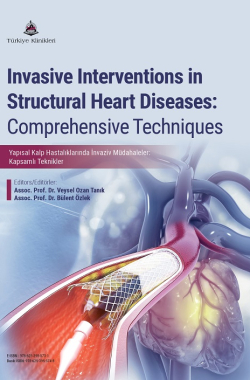INVASIVE DIAGNOSTICS (CARDIAC CATHETERIZATION, HEMODYNAMICS)
Yunus Çalapkulu
Ankara Mamak State Hospital, Department of Cardiology, Ankara, Türkiye
Çalapkulu Y. Invasive Diagnostics (Cardiac Catheterization, Hemodynamics). In: Tanık VO, Özlek B, editors. Invasive Interventions in Structural Heart Diseases: Comprehensive Techniques. 1st ed. Ankara: Türkiye Klinikleri; 2025. p.57-67.
ABSTRACT
Cardiac catheterization laboratories have evolved significantly over the decades. While hemodynamic assessments were crucial in the mid-20th century for diagnosing cardiovascular diseases, advancements in echocardiography during the 1980s and 1990s introduced noninvasive alternatives. However, catheterization remains indispensable for complex diagnostic cases, especially in congenital or structural heart diseases. Additionally, modern interventional procedures, such as balloon valvuloplasty and percutaneous valve implantation, provide treatment options for previously inoperable cases. Effective cardiac catheterization requires careful planning, including selecting the correct vascular access based on clinical needs. For example, radial or jugular access may be preferred for unexplained dyspnea, while transseptal catheterization is necessary for left atrial pressure measurements. Accurate assessments, particularly for pulmonary vascular resistance in transplant candidates, rely on appropriate catheters and techniques, with consistent monitoring crucial to avoid errors from issues like damping or thrombus formation. Key hemodynamic parameters, including preload, afterload, and cardiac output, are evaluated using techniques like thermodilution and the Fick method. Complex conditions, such as aortic stenosis, mitral stenosis, valve regurgitation, and congenital defects, often require catheterization when noninvasive findings are inconclusive. By refining their skills and eliminating errors, operators ensure accurate diagnoses and optimal patient care.
Keywords: Cardiac catheterization; Hemodynamics; Heart diseases
Kaynak Göster
Referanslar
- Nishimura RA, Tajik AJ. Quantitative hemodynamics by Doppler echocardiography: a noninvasive alternative to cardiac catheterization. Prog Cardiovasc Dis. 1994 ;36(4):309-42. [Crossref] [PubMed]
- Nishimura RA, Carabello BA. Hemodynamics in the cardiac catheterization laboratory of the 21st century. Circulation. 2012;125(17):2138-50. [Crossref] [PubMed]
- Reddy, Yogesh NV, Rick A. Nishimura. Hemodynamics for the structural interventionalist. Handbook of Structural Heart Interventions. Elsevier, 2021;43-56. [Crossref]
- Jaber WA, Sorajja P, Borlaug BA, Nishimura RA. Differentiation of tricuspid regurgitation from constrictive pericarditis: novel criteria for diagnosis in the cardiac catheterisation laboratory. Heart. 2009;95(17):1449-54. [Crossref] [PubMed]
- Sorajja P, Borlaug BA, Dimas VV, Fang JC, Forfia PR, Givertz MM, Kapur NK, Kern MJ, Naidu SS. SCAI/HFSA clinical expert consensus document on the use of invasive hemodynamics for the diagnosis and management of cardiovascular disease. Catheter Cardiovasc Interv. 2017;89(7):E233-E247. [Crossref]
- Reddy YNV, El-Sabbagh A, Nishimura RA. Comparing pulmonary arterial wedge pressure and left ventricular end diastolic pressure for assessment of left-sided filling pressures. JAMA Cardiol. 2018;3(6):453-454. [Crossref] [PubMed]
- Andersen MJ, Borlaug BA. Invasive hemodynamic characterization of heart failure with preserved ejection fraction. Heart Fail Clin. 2014;10(3):435-44. [Crossref] [PubMed]
- Borlaug BA, Kass DA. Invasive hemodynamic assessment in heart failure. Cardiol Clin. 2011;29(2):269-80. [Crossref] [PubMed]
- Schwartzenberg S, Redfield MM, From AM, Sorajja P, Nishimura RA, Borlaug BA. Effects of vasodilation in heart failure with preserved or reduced ejection fraction implications of distinct pathophysiologies on response to therapy. J Am Coll Cardiol. 2012;59(5):442-51. [Crossref] [PubMed]
- Assey ME, Zile MR, Usher BW, Karavan MP, Carabello BA. Effect of catheter positioning on the variability of measured gradient in aortic stenosis. Cathet Cardiovasc Diagn. 1993;30(4):287-92. [Crossref] [PubMed]
- Carabello BA. What is new in the 2006 ACC/AHA guidelines on valvular heart disease? Curr Cardiol Rep. 2008;10(2):85-90. [Crossref] [PubMed]
- Nishimura RA, Rihal CS, Tajik AJ, Holmes DR Jr. Accurate measurement of the transmitral gradient in patients with mitral stenosis: a simultaneous catheterization and Doppler echocardiographic study. J Am Coll Cardiol. 1994;24(1):152-8. [Crossref] [PubMed]
- Klarich KW, Rihal CS, Nishimura RA. Variability between methods of calculating mitral valve area: simultaneous Doppler echocardiographic and cardiac catheterization studies conducted before and after percutaneous mitral valvuloplasty. J Am Soc Echocardiogr. 1996;9(5):684-90. [Crossref] [PubMed]
- Carabello BA. The current therapy for mitral regurgitation. J Am Coll Cardiol. 2008 29;52(5):319-26. [Crossref] [PubMed]
- Masutani S, Senzaki H. Left ventricular function in adult patients with atrial septal defect: implication for development of heart failure after transcatheter closure. J Card Fail. 2011;17(11):957-63. [Crossref] [PubMed]
- Webb G, Gatzoulis MA. Atrial septal defects in the adult: recent progress and overview. Circulation. 2006;114(15):1645-53. [Crossref] [PubMed]
- Jaber WA, Nishimura RA, Ommen SR. Not all systolic velocities indicate obstruction in hypertrophic cardiomyopathy: a simultaneous Doppler catheterization study. J Am Soc Echocardiogr. 2007;20(8):1009.e5-7. [Crossref] [PubMed] [PMC]
- Geske JB, Cullen MW, Sorajja P, Ommen SR, Nishimura RA. Assessment of left ventricular outflow gradient: Hyperrophic cardiomyopathy versus aortic valvular stenosis. JACC Cardiovasc Interv 2012;5:675-681. [Crossref] [PubMed]

